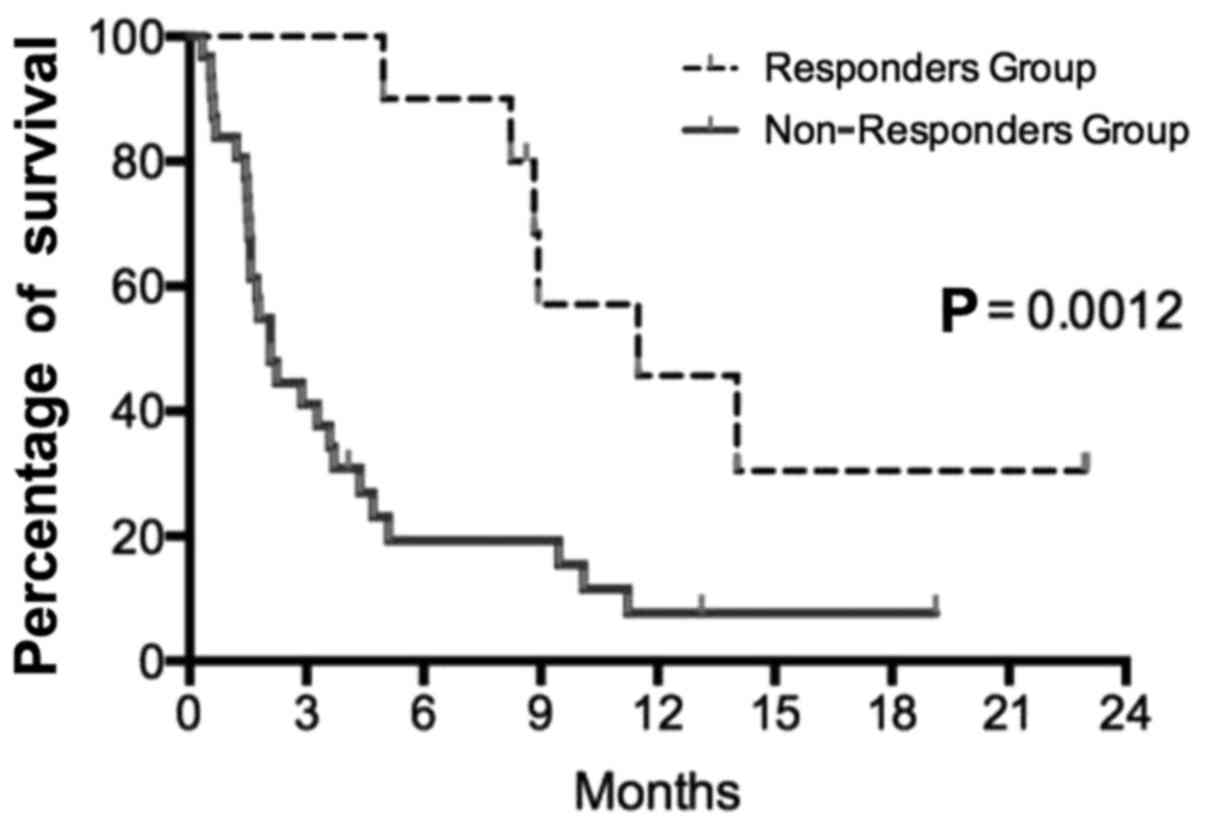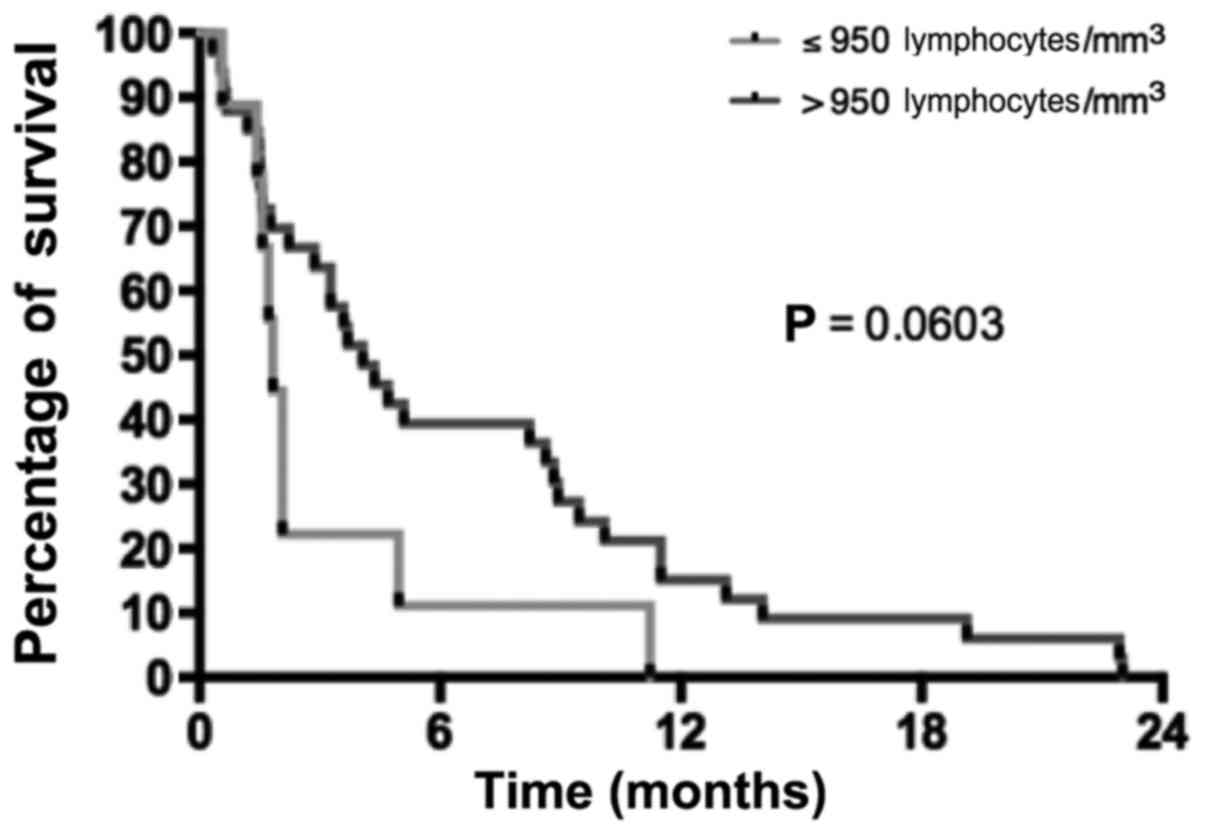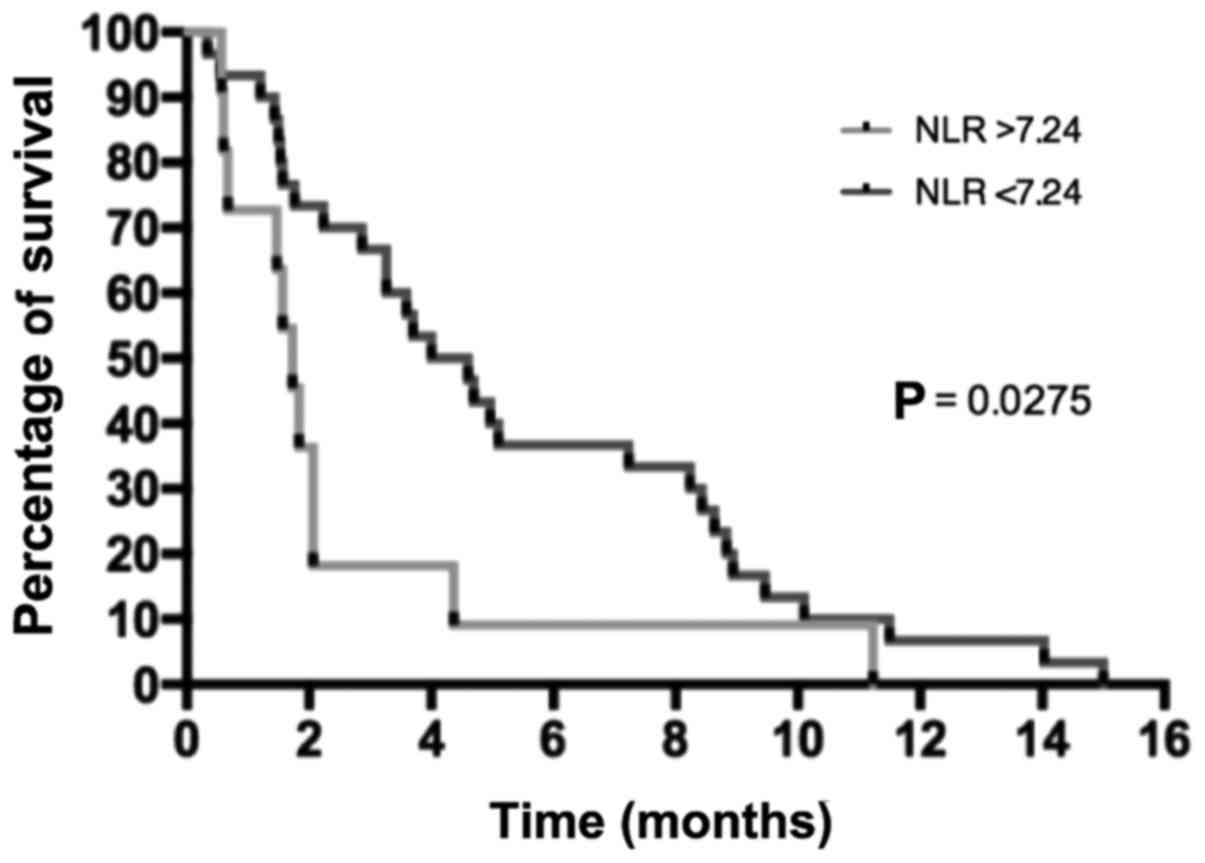|
1
|
Ferlay J, Shin HR, Bray F, Forman D,
Mathers C and Parkin DM: Estimates of worldwide burden of cancer in
2008: GLOBOCAN 2008. Int J Cancer. 127:2893–2917. 2010. View Article : Google Scholar : PubMed/NCBI
|
|
2
|
Burris H and Storniolo AM: Assessing
clinical benefit in the treatment of pancreas cancer: Gemcitabine
compared to 5-fluorouracil. Eur J Cancer. 33 Suppl 1:S18–S22. 1997.
View Article : Google Scholar : PubMed/NCBI
|
|
3
|
Burris HA III, Moore MJ, Andersen J, Green
MR, Rothenberg ML, Modiano MR, Cripps MC, Portenoy RK, Storniolo
AM, Tarassoff P, et al: Improvements in survival and clinical
benefit with gemcitabine as first-line therapy for patients with
advanced pancreas cancer: A randomized trial. J Clin Oncol.
15:2403–2413. 1997. View Article : Google Scholar : PubMed/NCBI
|
|
4
|
Conroy T, Desseigne F, Ychou M, Bouché O,
Guimbaud R, Bécouarn Y, Adenis A, Raoul JL, Gourgou-Bourgade S, de
la Fouchardière C, et al: FOLFIRINOX versus gemcitabine for
metastatic pancreatic cancer. N Engl J Med. 364:1817–1825. 2011.
View Article : Google Scholar : PubMed/NCBI
|
|
5
|
Oken MM, Creech RH, Tormey DC, Horton J,
Davis TE, McFadden ET and Carbone PP: Toxicity and response
criteria of the eastern cooperative oncology group. Am J Clin
Oncol. 5:649–655. 1982. View Article : Google Scholar : PubMed/NCBI
|
|
6
|
von Hoff DD, Ervin T, Arena FP, Chiorean
EG, Infante J, Moore M, Seay T, Tjulandin SA, Ma WW, Saleh MN, et
al: Increased survival in pancreatic cancer with nab-paclitaxel
plus gemcitabine. N Engl J Med. 369:1691–1703. 2013. View Article : Google Scholar : PubMed/NCBI
|
|
7
|
Pelzer U, Schwaner I, Stieler J, Adler M,
Seraphin J, Dörken B, Riess H and Oettle H: Best supportive care
(BSC) versus oxaliplatin, folinic acid and 5-fluorouracil (OFF)
plus BSC in patients for second-line advanced pancreatic cancer: A
phase III-study from the German CONKO-study group. Eur J Cancer.
47:1676–1681. 2011. View Article : Google Scholar : PubMed/NCBI
|
|
8
|
Tsavaris N, Kosmas C, Skopelitis H,
Gouveris P, Kopterides P, Loukeris D, Sigala F, Zorbala-Sypsa A,
Felekouras E and Papalambros E: Second-line treatment with
oxaliplatin, leucovorin and 5-fluorouracil in
gemcitabine-pretreated advanced pancreatic cancer: A phase II
study. Invest New Drugs. 23:369–375. 2005. View Article : Google Scholar : PubMed/NCBI
|
|
9
|
Cantore M, Rabbi C, Fiorentini G, Oliani
C, Zamagni D, Iacono C, Mambrini A, Del Freo A and Manni A:
Combined irinotecan and oxaliplatin in patients with advanced
pre-treated pancreatic cancer. Oncology. 67:93–97. 2004. View Article : Google Scholar : PubMed/NCBI
|
|
10
|
Demols A, Peeters M, Polus M, Marechal R,
Gay F, Monsaert E, Hendlisz A and Van Laethem JL: Gemcitabine and
oxaliplatin (GEMOX) in gemcitabine refractory advanced pancreatic
adenocarcinoma: A phase II study. Br J Cancer. 94:481–485. 2006.
View Article : Google Scholar : PubMed/NCBI
|
|
11
|
Bauer TM, El-Rayes BF, Li X, Hammad N,
Philip PA, Shields AF, Zalupski MM and Bekaii-Saab T: Carbohydrate
antigen 19–9 is a prognostic and predictive biomarker in patients
with advanced pancreatic cancer who receive gemcitabine-containing
chemotherapy: A pooled analysis of 6 prospective trials. Cancer.
119:285–292. 2013. View Article : Google Scholar : PubMed/NCBI
|
|
12
|
Nagrial A, Chin VT, Sjoquist K, Chantrill
LA and Yip D: Survival benefit of second-line chemotherapy in
advanced pancreatic adenocarcinoma: A systematic review of the
literature. J Clin Oncol. 32:2962014. View Article : Google Scholar
|
|
13
|
Rahma OE, Duffy A, Liewehr DJ, Steinberg
SM and Greten TF: Second-line treatment in advanced pancreatic
cancer: A comprehensive analysis of published clinical trials. Ann
Oncol. 24:1972–1979. 2013. View Article : Google Scholar : PubMed/NCBI
|
|
14
|
Boeck S, Weigang-Köhler K, Fuchs M,
Kettner E, Quietzsch D, Trojan J, Stötzer O, Zeuzem S, Lordick F,
Köhne CH, et al: Second-line chemotherapy with pemetrexed after
gemcitabine failure in patients with advanced pancreatic cancer: A
multicenter phase II trial. Ann Oncol. 18:745–751. 2007. View Article : Google Scholar : PubMed/NCBI
|
|
15
|
Kulke MH, Blaszkowsky LS, Ryan DP, Clark
JW, Meyerhardt JA, Zhu AX, Enzinger PC, Kwak EL, Muzikansky A,
Lawrence C and Fuchs CS: Capecitabine plus erlotinib in
gemcitabine-refractory advanced pancreatic cancer. J Clin Oncol.
25:4787–4792. 2007. View Article : Google Scholar : PubMed/NCBI
|
|
16
|
Boeck S and Heinemann V: Second-line
therapy in gemcitabine-pretreated patients with advanced pancreatic
cancer. J Clin Oncol. 26:1178–1179. 2008. View Article : Google Scholar : PubMed/NCBI
|
|
17
|
International Union Against Cancer (UICC),
. TNM Classification of Malignant Tumours. Sobin LH, Gospodarowicz
M and Wittekind C: 7th. John Wiley & Sons, Ltd.; Chichester,
West Sussex: 2009
|
|
18
|
Therasse P, Arbuck SG, Eisenhauer EA,
Wanders J, Kaplan RS, Rubinstein L, Verweij J, van Glabbeke M, van
Oosterom AT, Christian MC and Gwyther SG: New guidelines to
evaluate the response to treatment in solid tumors. European
organization for research and treatment of cancer, national cancer
institute of the United States, national cancer institute of
Canada. J Natl Cancer Inst. 92:205–216. 2000. View Article : Google Scholar
|
|
19
|
Goldstein D, El-Maraghi RH, Hammel P,
Heinemann V, Kunzmann V, Sastre J, Scheithauer W, Siena S,
Tabernero J, Teixeira L, et al: nab-Paclitaxel plus gemcitabine for
metastatic pancreatic cancer: Long-term survival from a phase III
trial. J Natl Cancer Inst. 107:pii: dju413. 2015. View Article : Google Scholar
|
|
20
|
Gresham GK, Wells GA, Gill S, Cameron C
and Jonker DJ: Chemotherapy regimens for advanced pancreatic
cancer: A systematic review and network meta-analysis. BMC Cancer.
14:4712014. View Article : Google Scholar : PubMed/NCBI
|
|
21
|
Kaddis N and Saif MW: Second-line
treatment for pancreatic cancer. JOP. 15:344–347. 2014.PubMed/NCBI
|
|
22
|
Xiong HQ, Varadhachary GR, Blais JC, Hess
KR, Abbruzzese JL and Wolff RA: Phase 2 trial of oxaliplatin plus
capecitabine (XELOX) as second-line therapy for patients with
advanced pancreatic cancer. Cancer. 113:2046–2052. 2008. View Article : Google Scholar : PubMed/NCBI
|
|
23
|
Reni M, Cereda S, Mazza E, Passoni P,
Nicoletti R, Balzano G, Zerbi A, Arcidiacono PG, Staudacher C and
Di Carlo V: PEFG (cisplatin, epirubicin, 5-fluorouracil,
gemcitabine) regimen as second-line therapy in patients with
progressive or recurrent pancreatic cancer after
gemcitabine-containing chemotherapy. Am J Clin Oncol. 31:145–150.
2008. View Article : Google Scholar : PubMed/NCBI
|
|
24
|
Boeck S, Wilkowski R, Bruns CJ, Issels RD,
Schulz C, Moosmann N, Laessig D, Haas M, Golf A and Heinemann V:
Oral capecitabine in gemcitabine-pretreated patients with advanced
pancreatic cancer. Oncology. 73:221–227. 2007. View Article : Google Scholar : PubMed/NCBI
|
|
25
|
Reni M, Pasetto L, Aprile G, Cordio S,
Bonetto E, Dell'Oro S, Passoni P, Piemonti L, Fugazza C, Luppi G,
et al: Raltitrexed-eloxatin salvage chemotherapy in
gemcitabine-resistant metastatic pancreatic cancer. Br J Cancer.
94:785–791. 2006. View Article : Google Scholar : PubMed/NCBI
|
|
26
|
Burris HA III, Rivkin S, Reynolds R,
Harris J, Wax A, Gerstein H, Mettinger KL and Staddon A: Phase II
trial of oral rubitecan in previously treated pancreatic cancer
patients. Oncologist. 10:183–190. 2005. View Article : Google Scholar : PubMed/NCBI
|
|
27
|
Jacobs AD, Burris HA, Rivkin S, Ritch PS,
Eisenberg PD and Mettinger KL: A randomized phase III study of
rubitecan (ORA) vs. best choice (BC) in 409 patients with
refractory pancreatic cancer report from a North-American
multi-center study. J Clin Oncol. 22:4013. 2004. View Article : Google Scholar
|
|
28
|
Ulrich-Pur H, Raderer M, Kornek G Verena,
Schüll B, Schmid K, Haider K, Kwasny W, Depisch D, Schneeweiss B,
Lang F and Scheithauer W: Irinotecan plus raltitrexed vs
raltitrexed alone in patients with gemcitabine-pretreated advanced
pancreatic adenocarcinoma. Br J Cancer. 88:1180–1184. 2003.
View Article : Google Scholar : PubMed/NCBI
|
|
29
|
Kozuch P, Grossbard ML, Barzdins A, Araneo
M, Robin A, Frager D, Homel P, Marino J, DeGregorio P and Bruckner
HW: Irinotecan combined with gemcitabine, 5-fluorouracil,
leucovorin, and cisplatin (G-FLIP) is an effective and
noncrossresistant treatment for chemotherapy refractory metastatic
pancreatic cancer. Oncologist. 6:488–495. 2001. View Article : Google Scholar : PubMed/NCBI
|
|
30
|
Altwegg R, Ychou M, Guillaumon V, Thezenas
S, Senesse P, Flori N, Mazard T, Caillo L, Faure S, Samalin E and
Assenat E: Second-line therapy for gemcitabine-pretreated advanced
or metastatic pancreatic cancer. World J Gastroenterol.
18:1357–1364. 2012. View Article : Google Scholar : PubMed/NCBI
|
|
31
|
Wang-Gillam A, Li CP, Bodoky G, Dean A,
Shan YS, Jameson G, Macarulla T, Lee KH, Cunningham D, Blanc JF, et
al: Nanoliposomal irinotecan with fluorouracil and folinic acid in
metastatic pancreatic cancer after previous gemcitabine-based
therapy (NAPOLI-1): A global, randomised, open-label, phase 3
trial. Lancet. 387:545–557. 2016. View Article : Google Scholar : PubMed/NCBI
|
|
32
|
Proctor MJ, Horgan PG, Talwar D, Fletcher
CD, Morrison DS and McMillan DC: Optimization of the systemic
inflammation-based Glasgow prognostic score: A Glasgow Inflammation
Outcome Study. Cancer. 119:2325–2332. 2013. View Article : Google Scholar : PubMed/NCBI
|
|
33
|
Glen P, Jamieson NB, McMillan DC, Carter
R, Imrie CW and McKay CJ: Evaluation of an inflammation-based
prognostic score in patients with inoperable pancreatic cancer.
Pancreatology. 6:450–453. 2006. View Article : Google Scholar : PubMed/NCBI
|
|
34
|
La Torre M, Nigri G, Cavallini M,
Mercantini P, Ziparo V and Ramacciato G: The Glasgow prognostic
score as a predictor of survival in patients with potentially
resectable pancreatic adenocarcinoma. Ann Surg Oncol. 19:2917–2923.
2012. View Article : Google Scholar : PubMed/NCBI
|
|
35
|
Shimoda M, Katoh M, Kita J, Sawada T and
Kubota K: The Glasgow prognostic score is a good predictor of
treatment outcome in patients with unresectable pancreatic cancer.
Chemotherapy. 56:501–506. 2010. View Article : Google Scholar : PubMed/NCBI
|
|
36
|
Johansen JS, Vibat CRT, Hancock S, Chen I,
Hassaine L, Samuelsz E, Collisson EA, Jensen VB, Lu T, Melnikova V
and Erlander MG: Prognostic value of plasma circulating tumor (ct)
DNA KRAS mutations and serum CA19-9 in unresectable pancreatic
cancer (PC) patients. ASCO Meeting Abstracts. 33:pp. 40222015;
|
|
37
|
Wei CH, Gorgan TR, Elashoff DA, Hines OJ,
Farrell JJ and Donahue TR: A meta-analysis of gemcitabine
biomarkers in patients with pancreaticobiliary cancers. Pancreas.
42:1303–1310. 2013. View Article : Google Scholar : PubMed/NCBI
|
|
38
|
Farrell JJ, Elsaleh H, Garcia M, Lai R,
Ammar A, Regine WF, Abrams R, Benson AB, Macdonald J, Cass CE, et
al: Human equilibrative nucleoside transporter 1 levels predict
response to gemcitabine in patients with pancreatic cancer.
Gastroenterology. 136:187–195. 2009. View Article : Google Scholar : PubMed/NCBI
|
|
39
|
Maréchal R, Bachet JB, Mackey JR, Dalban
C, Demetter P, Graham K, Couvelard A, Svrcek M, Bardier-Dupas A,
Hammel P, et al: Levels of gemcitabine transport and metabolism
proteins predict survival times of patients treated with
gemcitabine for pancreatic adenocarcinoma. Gastroenterology.
143:664–674.e1-e6. 2012. View Article : Google Scholar : PubMed/NCBI
|
|
40
|
Greenhalf W, Ghaneh P, Neoptolemos JP,
Palmer DH, Cox TF, Lamb RF, Garner E, Campbell F, Mackey JR,
Costello E, et al: Pancreatic Cancer hENT1 expression and survival
from gemcitabine in patients from the ESPAC-3 trial. J Natl Cancer
Inst. 106:djt3472014. View Article : Google Scholar : PubMed/NCBI
|
|
41
|
Sinn M, Riess H, Sinn BV, Stieler JM,
Pelzer U, Striefler JK, Oettle H, Bahra M, Denkert C, Bläker H and
Lohneis P: Human equilibrative nucleoside transporter 1 expression
analysed by the clone SP 120 rabbit antibody is not predictive in
patients with pancreatic cancer treated with adjuvant
gemcitabine-Results from the CONKO-001 trial. Eur J Cancer.
51:1546–1554. 2015. View Article : Google Scholar : PubMed/NCBI
|
|
42
|
Ormanns S, Heinemann V, Raponi M, Isaacson
J, Laubender RP, Haas M, Kruger S, Kleespies A, Mann E,
Bartosiewicz M, et al: Human equilibrative nucleoside transporter 1
is not predictive for gemcitabine efficacy in advanced pancreatic
cancer: Translational results from the AIO-PK0104 phase III study
with the clone SP120 rabbit antibody. Eur J Cancer. 50:1891–1899.
2014. View Article : Google Scholar : PubMed/NCBI
|
|
43
|
Poplin E, Wasan H, Rolfe L, Raponi M,
Ikdahl T, Bondarenko I, Davidenko I, Bondar V, Garin A, Boeck S, et
al: Randomized, multicenter, phase II study of CO-101 versus
gemcitabine in patients with metastatic pancreatic ductal
adenocarcinoma: Including a prospective evaluation of the role of
hENT1 in gemcitabine or CO-101 sensitivity. J Clin Oncol.
31:4453–4461. 2013. View Article : Google Scholar : PubMed/NCBI
|
|
44
|
Bertocchi P, Abeni C, Meriggi F, Rota L,
Rizzi A, Di Biasi B, Aroldi F, Ogliosi C, Savelli G, Rosso E and
Zaniboni A: Gemcitabine plus nab-paclitaxel as second-line and
beyond treatment for metastatic pancreatic cancer: A single
institution retrospective analysis. Rev Recent Clin Trials.
10:142–145. 2015. View Article : Google Scholar : PubMed/NCBI
|
|
45
|
Portal A, Pernot S, Tougeron D, Arbaud C,
Bidault AT, de la Fouchardière C, Hammel P, Lecomte T, Dréanic J,
Coriat R, et al: Nab paclitaxel plus gemcitabine for metastatic
pancreatic adenocarcinoma after Folfirinox failure: Results of an
AGEO multicenter prospective cohort. Br J Cancer. 113:989–995.
2015. View Article : Google Scholar : PubMed/NCBI
|
|
46
|
Palacio S, Akunyili II, Ernani V, et al:
Gemcitabine (Gem) and nab-paclitaxel (nab-P) in patients (pts) with
refractory advanced pancreatic cancer. Am Soc Clin Oncol. (Suppl
3): S4132015. View Article : Google Scholar
|













